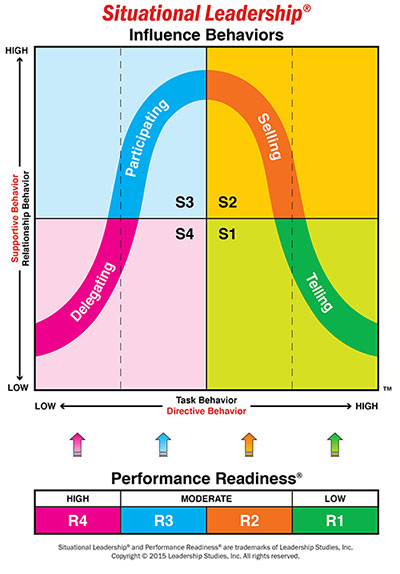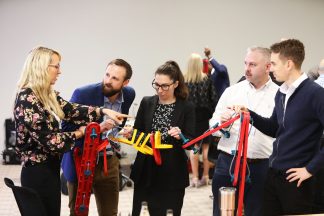Bring Situational Leadership to life with MTa experiential activities
Part of our series on bringing theories to life with experiential learning. Read the rest here.
Situational Leadership is a methodology designed to help leaders find the right leadership style at the right time. By providing a framework through which situations can be analysed, the model enables leaders to tailor their approach and lead in a way that is understood, accepted, and conducive to high performance.
In this post we’ll explore how experiential learning can build upon the insights revealed by Situational Leadership. We’ll also recommend handpicked MTa activities facilitators can use to bring the learning to life, and to carry these learnings forward into the workplace.
Here’s what we’ll cover:
- An introduction to Situational Leadership
- How Situational Leadership interfaces with experiential learning methodologies
- Taking the learning further
- MTa activities to bring Situational Leadership to life
Readers who are familiar with Situational Leadership can click here to skip to the recommended activities.
An introduction to Situational Leadership
The Situational Leadership methodology was developed in 1969 by Paul Hersey: a behavioural scientist with an array of books and publications, and an extensive career of speaking and consultancy around management and leadership.
The methodology was revalidated in 2011 to ensure its ongoing relevance and utility in a world where workplaces look quite different to how they would have in 1969.
Hersey developed Situational Leadership to provide a framework through which leaders could analyse situations and, depending on the relationship between leaders and followers, select the most appropriate leadership style. The broader aims were to accelerate the pace and quality of development in an organisation, and to foster a productive and communicative culture.
The quadrant below sits at the heart of the Situational Leadership methodology. The x axis shows Task Behavior, the y axis shows Relationship Behavior, and the relationship between them determines the correct Influence Behavior to use in each situation:

- Low Relationship Behavior and low Task Behavior = Delegating Influence Behavior, style 4
- High Relationship Behavior and low Task Behavior = Participating Influence Behavior, style 3
- High Relationship Behavior and high Task Behavior = Selling Influence Behavior, style 2
- High Relationship Behavior and low Task Behavior = Telling Influence Behavior, style 1
Each Influence Behavior is associated with a leadership style considered most appropriate for the Relationship and Task Behaviors.
The four Situational Leadership styles
Here are the four Situational Leadership styles, which the leader will select from depending on the amount of supervision and feedback the task demands. The numbers refer to the quadrant above:
S1: Telling, directing, or guiding: the leader makes decisions and provides close supervision throughout, with timely feedback made possible by this close observation.
S2: Selling, coaching, or explaining: the leader makes decisions and stays accessible while facilitating supportive two-way communication.
S3: Participating, collaborating, or facilitating: the follower makes decisions and discusses them with the leader, then implements the plan and solicits feedback.
S4: Delegating, empowering, or monitoring: the follower makes and influences decisions, and the leader trusts them to deliver results and feedback.
The effectiveness of each leadership style depends on a metric called Performance Readiness, which you can see in the table below the quadrant above. The higher the Performance Readiness, the more able and willing somebody is to undertake a task with less leadership.
An intro to Performance Readiness
Performance Readiness determines the most appropriate leadership style, and this metric can evolve within and between tasks. As situations develop and change, different leadership methods may become more appropriate than others, and the Situational Leadership model helps leaders to put change into perspective, to adapt to it, and to set out on a new and effective path forward.
What stands Situational Leadership apart from other leadership theories?
Situational Leadership is built on the twin principles that there is no one-size-fits-all leadership style, and that the right style depends on the characteristics of the situation.
This makes the methodology applicable and useful for individuals, teams, executives, managers, and beyond, rather than restricting it to people in or aspiring to be in leadership positions.
Situational Leadership also aims to facilitate multidirectional communication, allowing people in leadership roles to become receptive to influence from those being led. While this trait is common amongst some other leadership theories, it is far from guaranteed. Such communication is crucial for fostering organisational engagement and a culture of growth.
How Situational Leadership interfaces with experiential learning methodologies
To understand how Situational Leadership can interface with experiential learning, let’s take a look at the four competencies that a Situational Leader must be able to demonstrate:
- Diagnose: effective leaders need to be able to control impulses and think before they act. They need to identify the demands of the task, then to assess the ability and willingness of the person performing it.
- Adapt: effective leaders need to understand that no leadership style is ‘best’, and that the most suitable depends on the task and the person performing it. They need to understand that the leader’s role is to provide structure and guidance.
- Communicate: effective leaders need to be able to recognise strengths and areas for development, and to practise delivery of each leadership style regardless of their initial comfort levels.
- Advance: effective leaders accelerate development and reverse slippage of the people they’re developing.
Experiential learning provides a powerful conceptual framework in which these competencies and their associated behaviours can be explored. By simulating controlled scenarios, prospective leaders can see how different leadership styles and approaches manifest in and influence situations, as well as experimenting with leadership approaches that may not be appropriate or come naturally in real-world situations.
Our experiential learning kits and the activities they contain are all designed to facilitate specific learning outcomes, including those which mesh well with the competencies outlined above.
Taking the learning further: MTa activities to bring Situational Leadership to life
The handpicked activities below are particularly relevant to exploring the Situational Leadership methodology and its constituent parts, thanks to their ability to simulate scenarios in which various leadership styles and challenges can be explored.
Taller Stack
Learning opportunities for this activity:
- Awareness of others
- Self awareness
- Building on ideas
- Evaluating and judging
- Open but constructive critique
- Embracing change
- Valuing different perspectives
In the first half of this two-part activity, groups work separately to complete a task that requires thought, planning, and fast teamwork. In the second half, group membership is changed, formal leaders are introduced, and the activity is restarted.
By nominating individuals with assertive, dominant behaviours and promoting them to leadership roles in different groups, the facilitator is able to shift dynamics very quickly. This gives leaders and followers alike the opportunity to see how different leadership styles manifest, whether or not these leadership styles are suitable, and how Performance Readiness can manifest and be interpreted differently.
Taller Stack is part of MTa Insights.
Cable Car
Learning opportunities for this activity:
- Delegating
- Followership
- Gaining commitment
- Leading geographically separate teams
- Communicating
- Valuing others’ contributions
Cable Car is designed to introduce leadership skills whilst reinforcing effective team working, and sees the role of the leader evolve as the task progresses. Initially the leader must be strategic, but as participants gain expertise the leadership role shifts to become more facilitative: this presents the perfect opportunity to demonstrate and explore how different Influence Behaviors can become more suitable as a task develops.
Cable Car is part of MTa Insights and MTa STEM.
Promises Promises
Learning opportunities for this activity:
- Impact of different constraints on leaders and teams
- Leading different teams with different needs at the same time
- Identifying key organisational issues and allocating resources appropriately
- The impact of making commitments on behalf of others, without their consent
- Managing changing situations
- Effective communication between leaders and teams, and vice versa
Two teams must design, produce and cost different products, while relying on other teams and processes not fully within their control. This means that promises must be made, some of which, inevitably, cannot be kept. This activity is built on the assumption that things will go wrong, and as a result allows for more complex aspects of leadership to be explored.
The leader is also given two options for how to brief their teams: one directional, and one empowering. This aligns well with the S1 and S4 Situational Leadership styles, and provides a good opportunity to explore these in situ.
Promises, Promises is part of MTa Mini.
The Trailer
Learning opportunities for this activity:
- Teamworking
- Leadership
- The responsibilities of team membership
- Inter-group working
- Company versus departmental objectives
This activity sees two teams – designers and builders – working on different parts of the same project: first remotely, then in the same location. The activity provides a good context to explore delegation, leveraging personal skills and knowledge, and taking responsibility.
We recommend this activity for facilitators looking to explore different leadership styles and the evolving nature of Performance Readiness.
The Trailer is part of the MTa Team Kit.
Let us help you
The Situational Leadership methodology is a powerful framework and common language for the exploration and implementation of different leadership styles, according to the demands of the task and the capabilities of the people available to complete it. By building on participants’ understanding of Situational Leadership and its constituent ideas, experiential learning activities allow prospective leaders and participants alike to develop their learning and carry actionable learning outcomes into the workplace.
If you’re looking for ways to strengthen leadership skills, whether alongside Situational Leadership or otherwise, take a look at our experiential learning kits or book a call with Jamie to discuss your needs.

